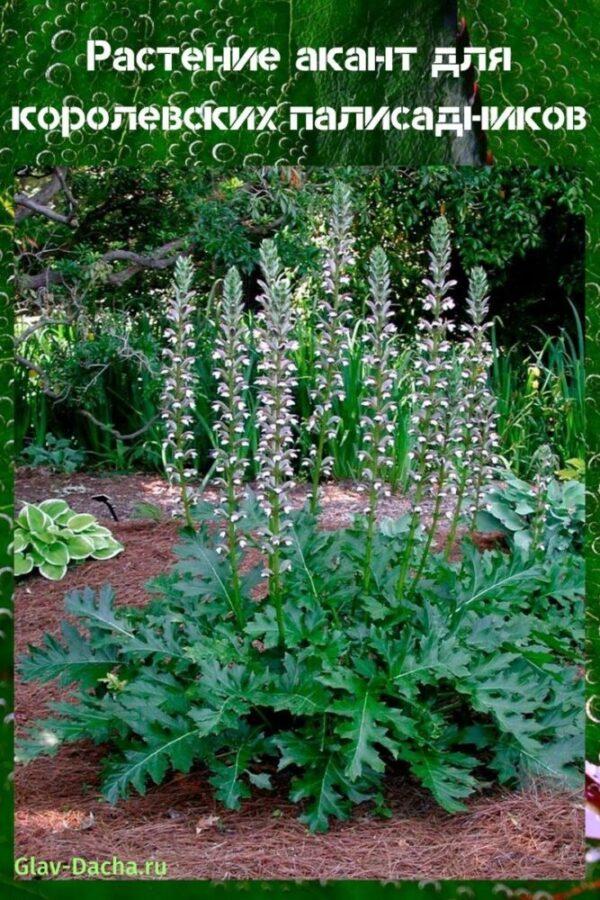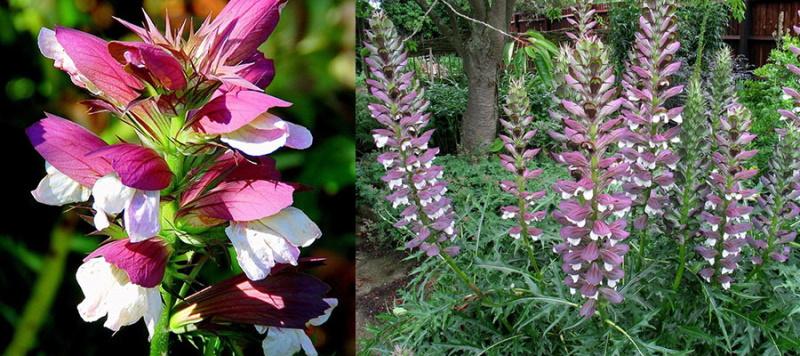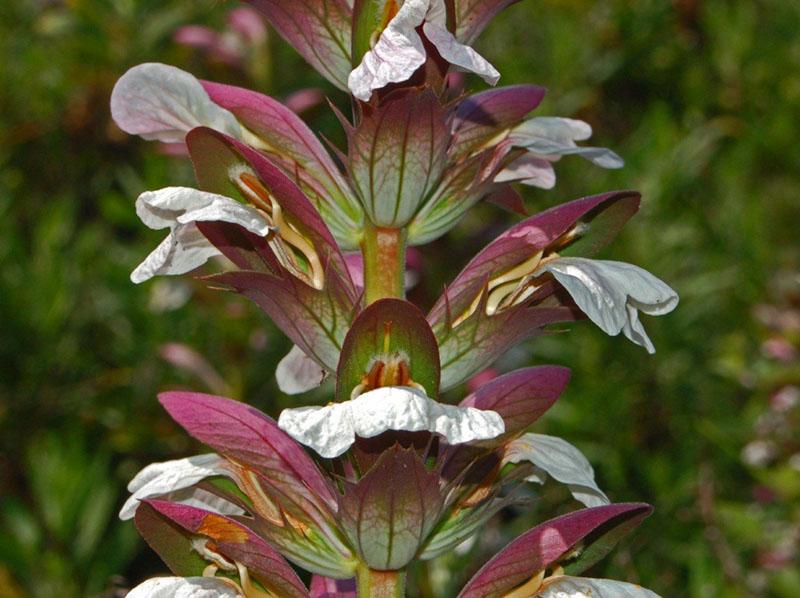Acanthus plant for royal front gardens
 For true connoisseurs of luxury and pomp, the acanthus plant will be a real find. An extraordinary flowering of culture exquisitely decorates the garden. One gets the impression that the personal plot has become the residence of the president himself.
For true connoisseurs of luxury and pomp, the acanthus plant will be a real find. An extraordinary flowering of culture exquisitely decorates the garden. One gets the impression that the personal plot has become the residence of the president himself.
The homeland of the representative of the Akantov family is the tropical and subtropical climate of Eurasia, Oceania, and Africa. In the northern latitudes, only 3 perennial varieties out of 30 existing in nature are cultivated. Nevertheless, each of them has special decorative properties.
Showy acanthus plant

Usually deciduous plates:
- large (length 50-100 cm, and width 30 cm);
- pinnate-lobed with slight concavity;
- dissected or separated;
- spiky;
- covered with thorns;
- dark green color;
- planted on long petioles (up to 50 cm);
- form a voluminous basal rosette.
Such features of the structure of acanthus leaves became an inspiration for many art workers of the ancient era. The craftsmen have created timeless masterpieces, incorporating original ornaments of exquisite foliage.
 The formation of culture buds is observed in late spring or summer (June-July). The duration of the period is 3-4 weeks. Strong flower stalks reach 0.5-2 m in height (there are also shrub varieties).
The formation of culture buds is observed in late spring or summer (June-July). The duration of the period is 3-4 weeks. Strong flower stalks reach 0.5-2 m in height (there are also shrub varieties).
Spike-shaped stems are covered with large flowers, petals (5 cm) of which shimmer with shades of such tones:
- white;
- red;
- pink;
- purple.
The flowering process in acanthus is not entirely straightforward. One season, the culture pleases with its lush racemose inflorescences, and in the second - only with spectacular foliage without flower buds.
 In addition, under the exquisite buds are refined bracts of a dark purple hue with pronounced thorns. This can explain the origin of the Latin name of the plant acanthus "Acanthus", which means "bract". This distinctive feature gives a certain mystery to the bear paws, since it seems that the young girls hid their luxurious heads behind hoods.
In addition, under the exquisite buds are refined bracts of a dark purple hue with pronounced thorns. This can explain the origin of the Latin name of the plant acanthus "Acanthus", which means "bract". This distinctive feature gives a certain mystery to the bear paws, since it seems that the young girls hid their luxurious heads behind hoods.
Popular varieties of acanthus
 An evergreen perennial is quite moisture and thermophilic. For this reason, not all known species are suitable for open ground.
An evergreen perennial is quite moisture and thermophilic. For this reason, not all known species are suitable for open ground.
Traditionally, only 3 hybrid varieties of acanthus are used for decorative purposes in modern gardening:
- mollis (A. mollis) or soft / dull (other names);

- prickly (A. Spinosus);

- Hungarian / Balkan (A. Hungaricus).

By the beginning of autumn, fruits are formed on the stems. Seed bolls are harvested as soon as they acquire a brownish tint.
The medium-sized acanthus mollis reaches a height of only 70 cm, although in the natural area the peduncles are up to 150 cm.The foliage forms a massive basal rosette of jade or green-sea shades. The width of the plates varies from 7 to 15 cm, and the length - from 30 to 60 cm. The shape of the leaves is roughly cut, but unlike other varieties, it is not decorated with thorns. This is why acanthus is called soft.
Florists should pay attention to the most luxurious variegated varieties of this species:
- "White water" (White water);

- Tasmanian Angel;

- Hollard's Gold;

- Morning Candle.

With a strong growth, the bush becomes quite high and spreading. In addition, self-seeding of the culture occurs, because the dried fruits burst, and the grains scatter within a radius of 10 m.
Mountain acanthus (badyan-leaved) is grown as a pot plant. The decorativeness of evergreen culture is given by glossy foliage with a dissected edging, which smoothly turns into thorns. Long peduncles (1.5-2 m) are beautifully crowned with white-purple flowers. A characteristic feature of the color of the petals of acanthus badyanolistny is the gradient effect: the snow-white tone closer to the base of the bud acquires a delicate purple hue.
Frost-resistant varieties include prickly and Hungarian. At the same time, the Balkan acanthus blooms much later than all the others.
The leading position in horticulture is occupied by A. spinosus or prickly. The openwork of its thinly dissected foliage, dotted with hundreds of thorns, fascinates all gardeners. Even the Royal Horticultural Society of Great Britain could not resist his charm. The variety has been awarded a prestigious award in this area.
Exotic cultivation by 3 methods
 For the acanthus plant, a suitable place is selected on the site. The flowerbed should be well lit (either in the morning or in the evening) and protected from drafts. The culture needs slight shading so that direct sunlight does not fall on the leaves. As already noted, acanthus grows strongly. In this case, special fences are installed around the perimeter to limit root growth. In this case, the widest / free front garden is selected for self-seeding of perennials.
For the acanthus plant, a suitable place is selected on the site. The flowerbed should be well lit (either in the morning or in the evening) and protected from drafts. The culture needs slight shading so that direct sunlight does not fall on the leaves. As already noted, acanthus grows strongly. In this case, special fences are installed around the perimeter to limit root growth. In this case, the widest / free front garden is selected for self-seeding of perennials.
For it, soil is recommended only with the following characteristics:
- easy;
- loose;
- moisture permeable;
- with a neutral or alkaline reaction.
In the process of digging the beds, peat (1 part) and sand (½ hour) are additionally introduced. To fertilize poor types of land, it is necessary to add humus and sod land. At the bottom of the hole, a good drainage layer is formed from broken brick, expanded clay or crushed stone. Acanthus does not tolerate stagnant water, especially in winter. Before planting, the substrate is abundantly watered with settled water.
Acanthus multiplies:
- delenki (the bush is divided into several parts);
- seeds;
- cuttings (stems or roots).
 For this reason, the technology of further planting depends on the chosen breeding method. All procedures are carried out in the spring. At the end, the plot is mulched with wood chips. Seeds passed scarification (processing with coarse material to damage the upper shell), are sown in separate cups with a nutritious soil substrate.
For this reason, the technology of further planting depends on the chosen breeding method. All procedures are carried out in the spring. At the end, the plot is mulched with wood chips. Seeds passed scarification (processing with coarse material to damage the upper shell), are sown in separate cups with a nutritious soil substrate.
Seedlings are grown in the usual way:
- cover with glass / film;
- watering and airing until germination;
- picking in the phase of 2-3 true leaves.
In open ground to a permanent place (the root system is very vulnerable), the seedlings are transferred at the end of May, when the threat of repeated frosts has passed. When propagated by cuttings, the stems are cut into 15-20 cm segments, and the roots - 5-8 cm (with an apical bud). In the first version, the resulting cutting is sent to the sand and covered with a bottle, and in the second, it is planted in a flower bed. The rooted sprout is transferred to the front garden.
Since acanthus is a thermophilic plant, experienced gardeners plant the culture in special masonry in order to remove them indoors for the winter. In other cases, young seedlings are covered with sawdust, spruce branches, litter or agrofibre.
Simple care
 Regular pruning, which is performed in early spring, will help protect perennials from freezing. In addition, during the entire growing season, fertilizing is applied every 2 weeks. Complex mineral fertilizers are usually used. Compost is added during the annual spring digging of the site. In addition, it also mulches the ground around the acanthus plant.
Regular pruning, which is performed in early spring, will help protect perennials from freezing. In addition, during the entire growing season, fertilizing is applied every 2 weeks. Complex mineral fertilizers are usually used. Compost is added during the annual spring digging of the site. In addition, it also mulches the ground around the acanthus plant.
 Among other things, a certain irrigation system must be introduced: 2-3 times a week, depending on weather conditions. Loosening of the soil is carried out regularly to provide the rhizome with oxygen. With such simple care procedures, acanthus will delight with its extraordinary flowering for more than 10 years.
Among other things, a certain irrigation system must be introduced: 2-3 times a week, depending on weather conditions. Loosening of the soil is carried out regularly to provide the rhizome with oxygen. With such simple care procedures, acanthus will delight with its extraordinary flowering for more than 10 years.